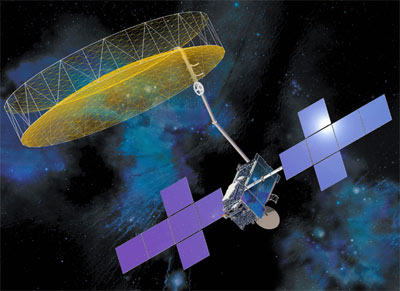Posted by samc on December 18th, 2007
Fat, drunk, and stupid is no way to go through life, son. — Animal House
A list of potential 700 MHz bidders was made available on the FCC’s Web site (pdf), late Tuesday. It has accepted 96 applications and reported 170 as incomplete (pdf). The latter need to be completed by Jan. 4.
 The FCC auction of 700-megahertz spectrum, is scheduled to begin on January 24. The FCC-run wireless auction is expected to take several weeks, with the spectrum to be auctioned off in several blocks.
The FCC auction of 700-megahertz spectrum, is scheduled to begin on January 24. The FCC-run wireless auction is expected to take several weeks, with the spectrum to be auctioned off in several blocks.
Microsoft co-founder Paul Allen was listed with an entity called Vulcan Spectrum LLC. Allen’s runs Vulcan Capital and is also a majority shareholder in U.S. cable operator Charter Communications.
Auction applicants included the usual suspects with, Google, AT&T, Verizon Wireless (Cellco Partnership), as well as Qualcomm and Frontline Wireless (Licenseco) making the list (or having to check it twice). EchoStar, aka Frontier Wireless, is also on board.
The accepted 700 MHz applicants with their bidding range are:
- Adams Telcom, Inc. 15,000,000 - 40,000,000
- Aeronet Wireless Broadband Corp. 0 - 15,000,000
- AlasConnect, Inc.
- Aristotle Inc. 0 - 15,000,000
- AWS Spectrum, LLC 15,000,000 - 40,000,000
- Bayou Internet, Inc.
- BEK Communications Cooperative 0 - 15,000,000
- Bend Cable Communications, LLC
- Blanca Telephone Company 15,000,000 - 40,000,000
- Blue Sky Cell, LLC 0 - 15,000,000
- Bluegrass Wireless LLC
- Bresnan Communications, Inc.
- Broadband Wireless Unlimited, LLC 15,000,000 - 40,000,000
- Budget Phone
- Cavalier Wireless, LLC 0 - 15,000,000
- Central Texas Telephone Investments, LP
- Chariton Valley Communication Corporation, Inc. 15,000,000 - 40,000,000
- Chester Telephone Company 15,000,000 - 40,000,000
- Clearcom, Inc.
- COLI INc 0 - 15,000,000
- Command Connect, LLC
- Cricket Licensee 2007, LLC
- Cross Telephone Company, LLC
- CTC Telcom, Inc.
- Data-Max Wireless LLC 0 - 15,000,000
- Delmarva Broadband LLC 0 - 15,000,000
- Ellijay Telephone Company
- Farmers Telecommunications Cooperative, Inc. 15,000,000 - 40,000,000
- Farmers Telephone Company, Inc.
- Fidelity Communications Company
- Forum Communications Company
- FTC Management Group, Inc.
- Glenwood Telephone Membership, Corporation 0 - 15,000,000
- Golden Belt Telephone Association, Inc. 15,000,000 - 40,000,000
- Google Airwaves Inc.
- Grain Spectrum LLC 0 - 15,000,000
- Great American Broadband, Inc. 0 - 15,000,000
- GreenFly LLC 0 - 15,000,000
- H & B Communications, Inc. 0 - 15,000,000
- Horry Telephone Cooperative, Inc.
- Inland Cellular Telephone Company
- IT&E Overseas, Inc. 15,000,000 - 40,000,000
- KeyOn Spectrum Holdings, LLC 0 - 15,000,000
- Kinex Networking Solutions, Inc. 0 - 15,000,000
- Kingdom Telephone Company 0 - 15,000,000
- Kurian, Thomas K 0 - 15,000,000
- Lackawaxen Long Distance Company, Inc.
- Landover PCS Holdings, LLC 0 - 15,000,000
- MAC Wireless, LLC
- Manti Telephone Company 0 - 15,000,000
- Medicine Park Telephone Company, Inc. 0 - 15,000,000
- Midwest AWS Limited Partnership 0 - 15,000,000
- Miller, David 0 - 15,000,000
- Mt. Vernnon.Net Inc. 0 - 15,000,000
- MTN3B Consortium 15,000,000 - 40,000,000
- Mulberry Cooperative Telephone Company, Inc 0 - 15,000,000
- N.E. Colorado Wireless Technologies, Inc.
- Neptuno Media 0 - 15,000,000
- Northeast Missouri Rural Telephone Company 0 - 15,000,000
- Northeast Nebraska Telephone Company 15,000,000 - 40,000,000
- Northern Iowa Communications Partners, LLC 15,000,000 - 40,000,000
- Panhandle Telecommunication Systems, Inc.
- Paul Bunyan Rural Telephone Cooperative, Inc.
- PBP Bidco LLC
- PCS Partners, L.P. 0 - 15,000,000
- Piedmont Rural Telephone Cooperative, Inc. 15,000,000 - 40,000,000
- Polar Communications Mutual Aid Corporation
- Public Service Wireless Services, Inc.
- Red River Rural Telephone Association, Inc.
- Sandhill Communications, LLC 15,000,000 - 40,000,000
- Siskiyou Telephone Company 15,000,000 - 40,000,000
- Small Ventures USA, L.P. 0 - 15,000,000
- Spectrum Acquisitions, Inc. 15,000,000 - 40,000,000
- Star Telephone Membership Corporation 15,000,000 - 40,000,000
- Swayzee Telephone Co. Inc. 0 - 15,000,000
- TCT West, Inc. 15,000,000 - 40,000,000
- Terra World Communications, LLC 0 - 15,000,000
- The Chillicothe Telephone Company
- The Tri-County Telephone Association, Inc. 0 - 15,000,000
- The World Company
- Towerstream Corporation 0 - 15,000,000
- Tri-Valley Communications, LLC
- Triad 700, LLC 0 - 15,000,000
- USA Choice Internet Services Company LLC 0 - 15,000,000
- Valley Telephone Cooperative, Inc. 15,000,000 - 40,000,000
- Van Buren Wireless, Inc. 0 - 15,000,000
- Vavasi NexGen Inc.
- Vermont Telephone Company, Inc. 15,000,000 - 40,000,000
- Vulcan Spectrum LLC
- Washington County Rural Telephone Cooperative, Inc 0 - 15,000,000
- West Wisconsin Telcom Cooperative, Inc. 15,000,000 - 40,000,000
- Wi2 0 - 15,000,0000002624856 Wireless Communications Venture
- Worldcall Inc. 0 - 15,000,000
- WUE, Inc. 0 - 15,000,000
- Xpressweb Internet Services, Inc. 0 - 15,000,000
The FCC’s AWS auction in September, 2006 (FCC summary) grossed $13.9 billion for the U.S. Treasury. T-Mobile USA, the No. 4 U.S. wireless provider, topped the bidding by offering almost $4.2 billion for 120 licenses.
 While the Bush Administration promised to “bridge the digital divide” with 90 MHz of new spectrum, it was cellular operators that benefited. San Antonio-based Cingular wanted the Bush administration to provide more spectrum for its GSM-based “3G”, but the company was ultimately allowed to buy Bell South.
While the Bush Administration promised to “bridge the digital divide” with 90 MHz of new spectrum, it was cellular operators that benefited. San Antonio-based Cingular wanted the Bush administration to provide more spectrum for its GSM-based “3G”, but the company was ultimately allowed to buy Bell South.
By the time the AWS auction finally happen, AT&T didn’t really need the additional spectrum. They pulled a similar maneuver, buying 700 MHz spectrum from Aloha Partners this October.
Germany’s T-Mobile wound up benefiting the most from the AWS auction.
The FCC carved up the AWS spectrum into FDD (dual-frequency) channels for 3G cellular operators, much like it has for 700 MHz. A better argument for duplex might be made in the 700 MHz band, however, due to the constrained 6MHz channels.
A “4G” system like Mobile WiMAX is optimized for TDD (single-frequency). It can deliver faster, cheaper, broadband by using COFDMA, scalable coding, beamforming and MIMO antennas on a single channel (much like Wi-Fi). Duplex would increase the cost. It put Mobile WiMAX at a competitive disadvantage on the AWS band since cellular operators already had infrastructure.
WiMAX can do FDD but it’s less efficient and wastes spectrum, say WiMAX proponents. That’s because one channel is mostly “listening”. And you need double the radios and antennas in a handset.
When it comes to FCC policy, money talks. Nevertheless, it appears that FCC Chief Kevin Martin has learned from the AWS exercise and has skillfully crafted a workable plan for the 700 MHz band. The proof may be revealed by the number of real competitors in next month’s auction.
The FCC, using AWS bidding figures, says next January’s auction could generate some $15 billion for the treasury, but actual bids could go much higher since 700 MHz requires only about one third the number of cell towers for similar coverage.
source : DailyWireless.org






































